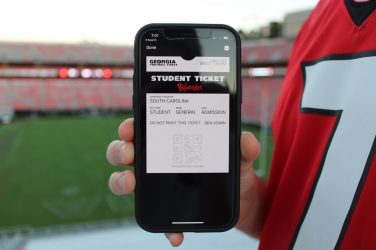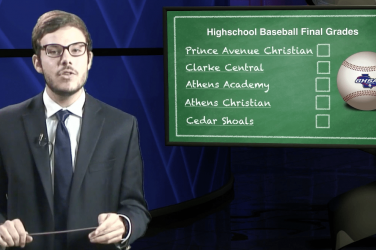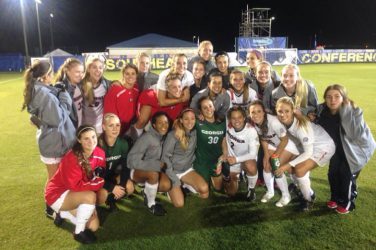It’s not just firing up the lawnmower 24 hours before a game day. It’s not just turning on the sprinkler systems periodically. And it’s not just painting straight white lines on the borders of the field.
Groundskeeping with the University of Georgia Athletic Association is a well-oiled machine, but not without its challenges.
Groundskeeper One
Zachary Townsend has been working on the groundskeeping crew at the South Milledge Turner Sports Complex since 2018, initially as a student before moving into a full-time role last year as Groundskeeper 1. The unit is responsible for the caretaking and maintenance of two Division 1 athletic programs’ official complexes, including a full-size soccer pitch, a collegiate softball diamond, two dual bullpens and a soccer training pitch.
Formally known as the Jack Turner Sports Complex, the facilities have played host to 11 NCAA Regionals and four NCAA Super Regionals in softball, as well as three NCAA Tournament matches for soccer.
“The biggest thing that I like about working out here, and grounds specifically, is the instant gratification that you get,” said Townsend about his experiences with grounds.
But the gratification does not come from a simple day’s work or a weekend of caretaking for Townsend and the groundskeeping crew. Being based in the Southeast of the country, specifically in Georgia, gratification in the groundskeeping work comes from overcoming the obstacles that the region throws your way.
Further, unforeseen difficulties arise for the crew from managing the facilities of such established programs with long histories of winning and fan engagement.
The Issues
Towering over the Jack Turner Sports Complex are Georgia pine trees in all directions. The pine trees that line the fields of play offer the competing players bits of shade in the hot months of the year. During the cooler, brisk months of the year, the trees can offer a break from the chilling winds. However, from a groundskeeper’s point of view, the trees offer something different.
“In years past, it’s just been so hard to keep grass growing on one side because it doesn’t get any sun throughout the whole day except for like, maybe an hour,” said Townsend on the challenges the pine trees present.
It’s no new tale that well-kept fields thrive with strong sunlight. Under low sunlight intensities, grass fields can succumb to thinner, longer leaves, reduced density, and shallow rooting, all factors that can lead to a poor field appearance and possible injury to players.
On top of sunlight issues, Townsend and the rest of the groundskeeping crew at the complex must combat weathering to high traffic areas of the field.
The challenges we have to face over there is foot traffic and worn spots, mainly right in front of the goal, and then right where they enter and exit [for substitutions],” said Townsend.
Last season, Georgia soccer hosted 11 home matches during its 23-game season. During a match, Georgia and its opponents will make upwards of 10 substitutions during a game, and the goalkeepers for both sides will make several saves. Therefore, the groundskeeping crew must account for the added foot traffic by players entering or exiting the field of play, as well as the wear of the grass underneath the goalkeepers’ feet as they plant their cleats to dive for a save.
And if varying degrees of sunlight and foot traffic was not challenging enough for Townsend and the groundskeepers, moisture control in the grass is also paramount.
“Softball, the biggest thing that we have, as I mentioned it, is the moisture control there on the field,” said Townsend about water levels. “You just kind of have to hope for the best as much as you practice and want to get watered down, and how much they want watered down.”
Georgia softball will open each season with four weeks of pre-season tournament play hosted at the complex. After the conclusion of tournament play, the team will gear up for a three-game series every weekend against Southeastern conference opponents with Wednesday home match-ups for a large portion of the regular season. Therefore, it becomes challenging for groundskeepers to manage the amount of water on the field that comes from scheduled irrigation or rain.
The Solutions
All the present challenges present at the Jack Turner Sports Complex are what give rise to the need for Townsend and the groundskeeping crew. In a perfect world, Townsend remarked at his wish to control the weather.
“If I could control that [poor weather] to maybe a weekend when we’re not here, or there’s not games, you know, that would just make life so much easier,” said Townsend.
However, life cannot be that simple, so the crew must rely on several practices to ensure they are prepared for the challenges that come their way. During the summer, when both teams are not playing or practicing, the groundskeeping crew will be hard at work. Like a sports team practices before the season for the real deal during the regular season, the groundskeeping practices during the summer to be ready for each season.
You kind of have to just practice for during, for when the season comes,” said Townsend.
The summer months are spent mowing regularly, but not too often to prevent a phenomenon known as “burning the grass.” Burning the grass refers to when an area is mowed too much, causing the grass to dry out and wither.
“It’s a lot of fertilizing rural sod places that we need to which is basically just taking up old spots that are worn down and putting brand new ready to place on,” said Townsend about summer preparations for worn areas on the fields.
Scheduled and strategic mowing helps to ensure that the fields are well-kept and maintained so when the respective seasons begin there is less risk of seriously overworn patches of grass when the respective seasons begin.
Further, during the off-season months, the groundskeeping crews rely on outside help. A Southeastern based company called Laserturf is hired to complete laser-leveling techniques on the fields. Laser-leveling, as the name suggests, involves projecting lasers across all major points of the playing fields to ensure the grass levels across all areas of the field are even.
After this process, the groundskeeping crew spends days watering and rolling the fields to ensure the water doesn’t get trapped in one spot, oversaturate one spot, and therefore ruin the laser-leveling process.
With the busy schedules that take effect during the sport seasons, the groundskeeping crew takes advantage of off months to ensure the durability and longevity of the fields. Spots that are highlighted for low levels of sunlight during the season are often targeted and trees are removed.
Areas on the fields that are highly susceptible to high traffic and weather are given special attention and replaced when needed. And the strategic mowing, laser-leveling, and heightened water and rolling practices ensure that different areas of the field do not succumb to poor moisture control and over-saturation.
A Complex to Thrive
While the challenges that the groundskeeping crew face can feel insurmountable at times, the reward of high-end product fields make the work worth it for Townsend and the crew.
“It’s nice,” said Townsend about the work of groundskeeping. “I like this pace of softball. All the coaches and players for softball are great. Same with soccer. And you know, it’s a good environment out here to just kind of do what we need to do without a lot of outside influence, unless we need it. So, it’s good to be independent out here too.”
Even though much of the work is behind the scenes, visitors take notice of the careful work that has gone into preparing and caring for the facilities — specifically visitors with an up-close view to the fields.
“I just always know exactly what it’s going to look like,” said Georgia softball outfielder Sydney Chambley, “and that’s also good for just preparation.”
Townsend and the groundskeeping crew focus on three key aspects when managing and caring for the fields: safety, playability, and aesthetics. Safety of the players, as well as safe keeping of the playing fields are of utmost importance. It’s why the groundskeeping crew spends so much time in the off seasons with the caretaking procedures to ensure the grass levels, moisture control and durability allow for the fields to be playable.
As long as those first two are good, these players are going to be safe, and it’s going to be playable. We can focus on aesthetics later.”
With a focus on safety and playability, the aesthetics can fall into place to create well-kept, properly maintained fields of play to thrive.
Sam Carter is a senior majoring in journalism at the University of Georgia.









Show Comments (0)